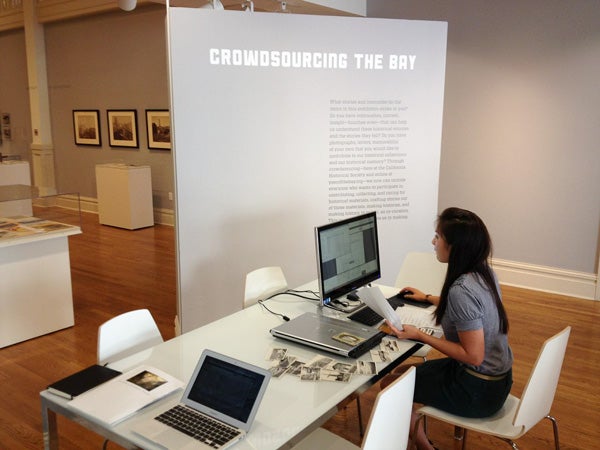|
May 21, 2013
Stanford humanities scholars harness the power of crowdsourcing
Researchers at Stanford's Center for Spatial and Textual Analysis are incorporating the knowledge and resources of the public into three digital humanities research projects. By Corrie Goldman

A Year of the Bay project officer scans and pins historical postcards at the California Historical Society exhibition. (Photo courtesy of The Stanford Center for Spatial and Textual Analysis)
Over the years, garage sale and used bookstore aficionado Michael Rettie has discovered dozens of historical photographs in forgotten boxes.
A new crowdsourcing project organized by Stanford researchers is enabling Rettie to post his finds on a publicly accessible virtual map that offers a nuanced picture of San Francisco Bay area history.
Rettie is one of many amateur historical researchers contributing to Year of the Bay, the first of three crowdsourcing experiments underway at Stanford.
Crowdsourcing holds the promise of enabling scholars "to engage people locally, across the country, and around the world in real research," said Zephyr Frank, an associate professor of history and director of Stanford's Center for Spatial and Textual Analysis (CESTA), which is conducting the experiments with support from the Andrew W. Mellon Foundation.
While Year of the Bay seeks to tap a general audience for new historical sources, the 500 Novels project is looking for a specific group: fans of British novels are being asked to help map how London was represented in 18th- and 19th-century literature.
The third project, Living with Railroads, connects amateur railroad buffs with scholars to test whether their different sources and interpretations can be combined to better understand the rapid expansion of railroad networks in the 19th century and how the railroads changed communities across the United States.
All three experiments bring together digital humanities scholars from Stanford's Literary Lab and Spatial History Lab at CESTA, with colleagues at other universities, libraries, museums and archives. Stanford students are working on the projects as research assistants supported by the Office of the Vice-Provost for Undergraduate Education.
Big year for Bay Area
The Year of the Bay project aims to take advantage of big public events in the San Francisco Bay area in 2013 – the America's Cup yacht races, the opening of a new span of the San Francisco-Oakland Bay Bridge, the 150th anniversary of the Port of San Francisco and dozens of commemorations at museums, libraries, and archives – to encourage people from diverse communities around the bay to share their different histories.
The endeavor also "seeks to test how well crowdsourcing initiatives can build upon the enthusiasm and interest created by local or regional events," said Jon Christensen, an environmental historian at the University of California-Los Angeles who is working with CESTA on Year of the Bay.
Developed as a collaboration between Stanford researchers and Historypin, a nonprofit organization that facilitates the sharing of historical materials online, the Year of the Bay site was launched in April 2013 in conjunction with "Curating the Bay," an exhibition at the California Historical Society in San Francisco.
Year of the Bay has already attracted hundreds of submissions, both online and at the exhibition "pinning station" where visitors can add their own photographs and memories to the project during community events at the California Historical Society.
"We hope that crowdsourcing will enable us to give voice to the diverse ethnic communities around the bay and their experiences, which are often missing from historical archives," said Christensen, who curated the exhibition, which is showing this spring and summer.
The crowdsourcing debate
Crowdsourcing appears to hold a great deal of potential for historians, but there is, however, great debate about the "usefulness of crowdsourcing for scholarly research," Frank said, and "very little research on the best ways to engage the public in providing truly useful information in the process."
Each of the Stanford crowdsourcing experiments seeks to "use technology to advance scholarly research through engaging the public beyond the walls of the university," said Frank.
At the same time, he said, each experiment will "test how well crowdsourcing works with different communities and for different kinds of research problems."
The three projects taken together, he added, will help scholars better understand both the possibilities and limitations of the use of crowdsourcing in the humanities.
Frank said the experiments are an important step in the development of the digital humanities.
"Computer technology offers powerful new tools for humanities research, and we're taking advantage of them in all kinds of ways at Stanford," he said. "Crowdsourcing has exciting potential for augmenting our research and scholarship in important ways. But technology and the crowd cannot replace the crucial humanistic work of critical analysis and interpretation. That's why we have to do these experiments and carefully evaluate the results."
Camille Brown, an intern with the Human Experience, contributed to this story.
-30-
|